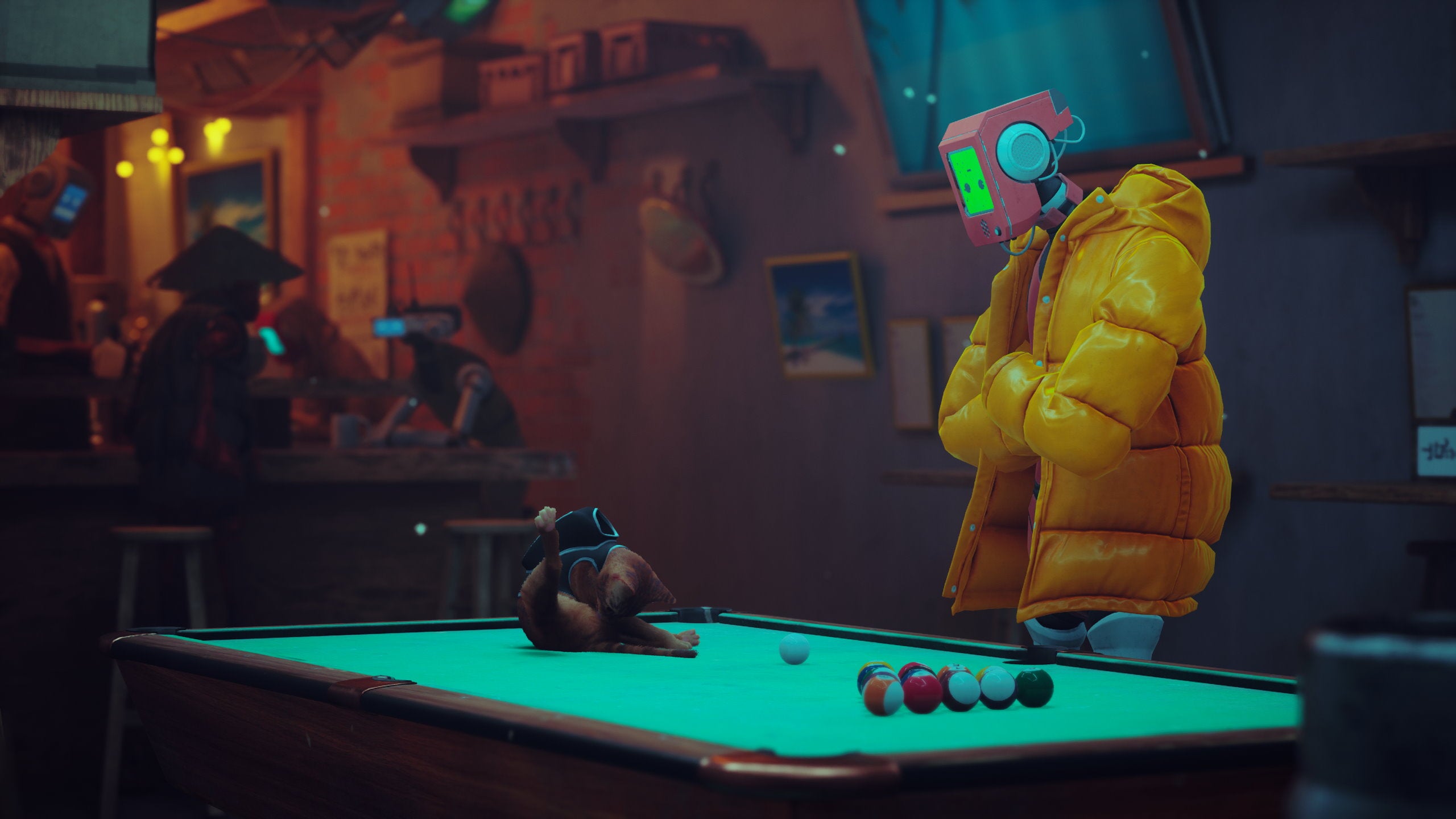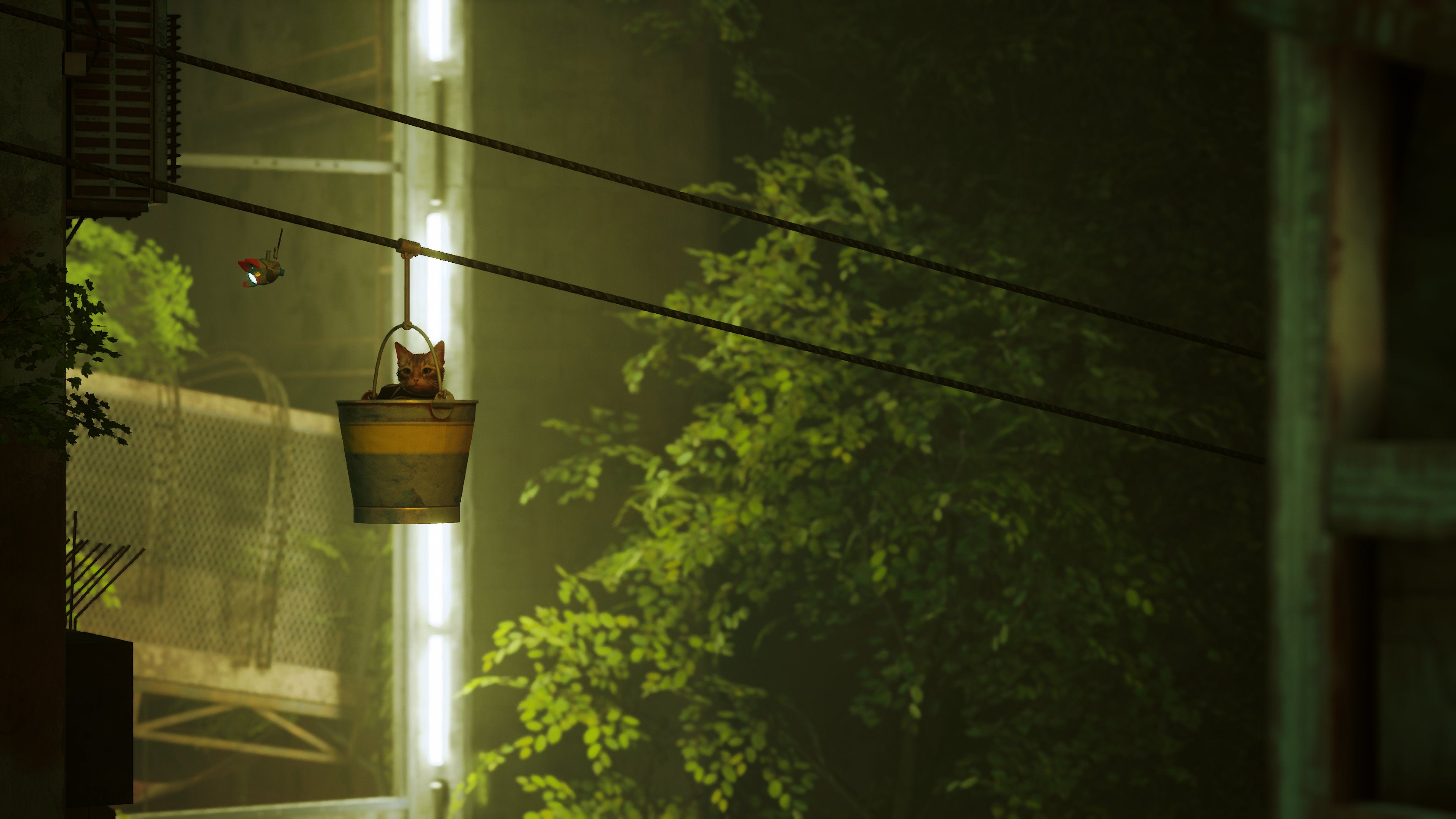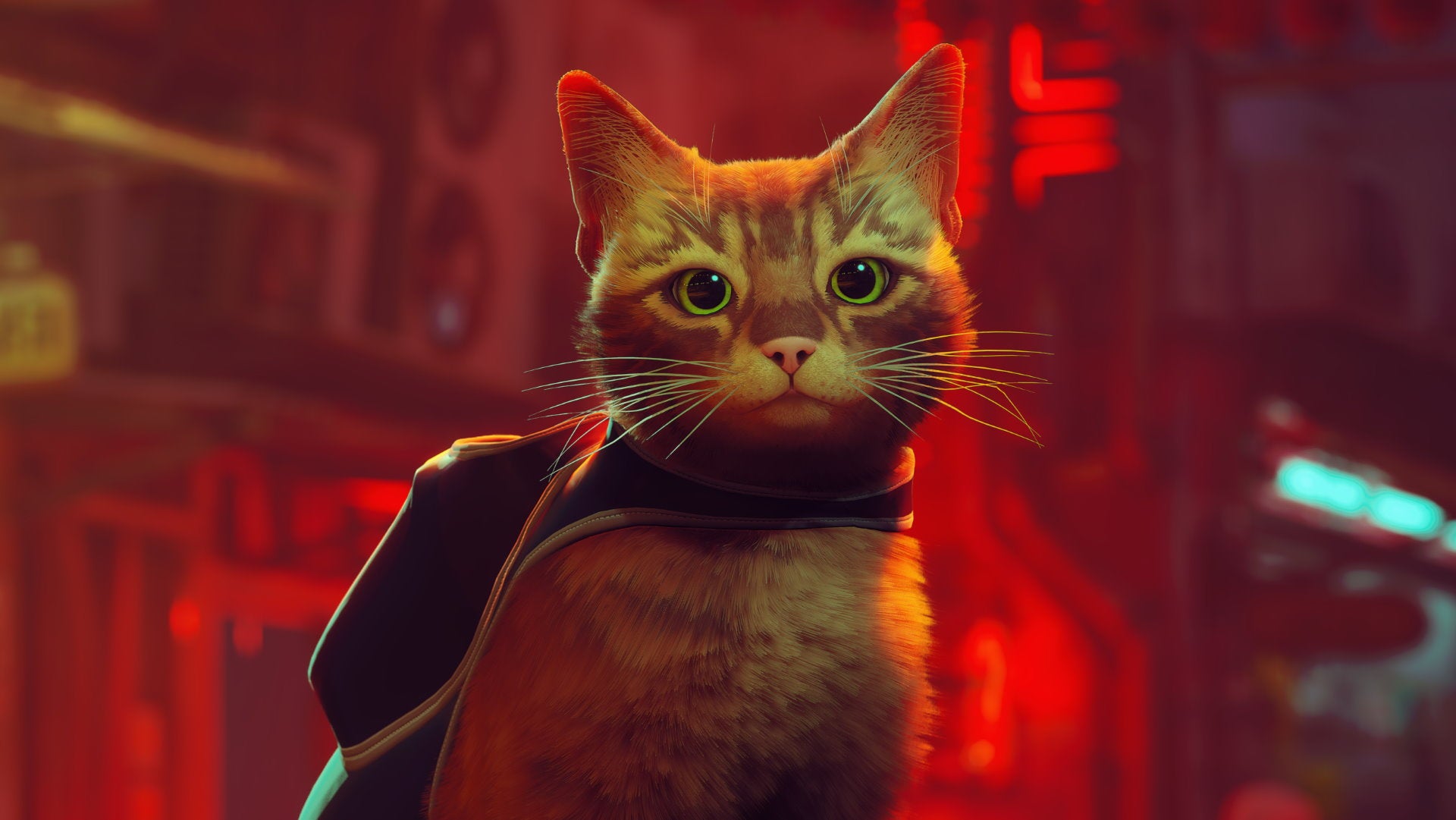Products You May Like
When I look outside my window, I often see our two cats scrabbling up our back wall as they hop over the fence to visit the neighbour’s garden. Up and down they go, covering distances seemingly impossible for their tiny, wiry frames, yet without coming to any harm whatsoever. It’s an instinct the team at BlueTwelve Studio know all too well, having modelled their unnamed cat protagonist in their debut adventure game Stray after a couple of their own feline companions – and colleagues, it turns out.
“About 80% of the team are cat owners, or are being owned by a cat depending on how you see it,” says producer Swann Martin-Raget. “We actually have two cats that are joining us almost everyday at the office and are working with us. The main character is based on one of the director’s cats called Murtaugh. He’s not an exact copy, but he’s the main reference. We also have Oscar, who is a Sphynx, a furless cat, so he’s a very good reference for animation because we can clearly see all the movements. We also have a lot of strays that we’ve adopted, but yeah, we definitely are huge cat lovers and these animals are fascinating to us.”

Indeed, during our 30-odd minute tour of one of Stray’s early dystopian cyberscapes, BlueTwelve’s deep love of cats immediately bubbled to the surface. Despite being alone, injured and separated from his family, your feline protagonist is an instantly warm and playful presence in its sea of metal, neon lights and dilapidated robots. There’s a dedicated meow button, for example, as well as button cues to knead carpets, scratch the backs of worn out sofas and, of course, push precariously placed paint pots off the edge of tall ledges. Classic cat-isms, in other words, that have all been lovingly animated by hand, Martin-Raget tells us, rather than mo-capped.
You’ll be using your agility and mischievous nature to explore and navigate this strange new environment, working out its rules and how you’re going to escape, Martin-Raget explains. However, one rather more mechanical rule you’ll come up against quite quickly when playing Stray is the limitation around your ability to jump. Your four-legged friend can only leap onto a platform when you see the safe assurance of a button prompt at your intended destination, you see, meaning you can’t accidentally fall to your death or miss a jump. Since our demo was hands off, it’s hard to say exactly how much this will affect the flow of our exploration when Stray finally launches on July 19th, but Martin-Raget tells us it was one of the only ways the team were able to prevent their playtesters from mis-reading the environment.

“Quite early in the project, we moved away from classic platforming challenges. We did some tests with some people and seeing people constantly missing their jumps really didn’t feel cat-like, and the fantasy of being a cat that was in our mind was all about being smooth and being able to easily go where you want to, so we came up with this compromise of being able to have jumps in the game that are really easy to do but also allow for a lot of freedom. You’re still able to choose your path, you’re still able to go everywhere you want to go, but in a very smooth and agile way.”
“The fantasy of being a cat that was in our mind was all about being smooth and being able to easily go where you want to.”
In BlueTwelve’s defence, I’m not sure I’d fancy my chances navigating this robo city without that extra bit of help, either. Even through the slight haze of our Discord stream, it was clear that Stray’s cyber city was packed to the brim with small little details just waiting to be poked and pawed at. Boxes and bottles are scattered through alleyways and propped up on balconies, pipes stack and doubleback to create makeshift stairways, abandoned TVs blare out in a haze of static on rooftops, and buckets hang in the air on pieces of string, just waiting for a conveniently-sized passenger to send it plummeting downwards. As that old saying goes, if it fits, it sits.
A few UI prompts, then, are welcome additions in my eyes, especially when the rest of the screen is completely free of other HUD elements. The camera does a brilliant job of framing your cat’s journey through this mysterious world, but it’s not so rigid that you feel penned in. Indeed, while some sections of the city are more linear than others, its squares and main thoroughfares look to be tantalisingly open playgrounds to clamber about in. Most importantly, they look like completely natural, lived in places as well, not artifical creations designed for video game cats to waltz through unimpeded. Air conditioning units make for surprisingly handy ledges, for example, as do vending machines, awnings, gutter pipes, and metal barrels.

It’s not all about just nosing around and being a lovely little nuisance, though. In a later segment, we were shown the cat being chased by swarms of bug-like creatures called the Zurk with big glowing eyes, which were spilling in from all angles in a luminous green sewer. Here, you’ll have to use your platforming smarts and a bit of quick thinking to outmanoeuvre them and make your escape. Unlike its more sedate exploration sections, you can die in these action sequences, Martin-Raget says, giving the game some kind of stakes, though your punishment for failure is still relatively light – just a quick respawn at the last checkpoint. But even in moments of relative calm you’ll still need to exert a bit of lateral thinking to solve some of its clever-looking physics puzzles that let you manipulate the environment. (And if you think a cat using its weight to swing rotating platforms from side to side as you jump between them is too farfetched, let me introduce you to my cat Midna, who can open every door in my house by jumping up and hanging off the handle).
You’re also not entirely alone on your journey. Early on, you’ll acquire a little backpack that houses a tiny robot pal called B-12. He’s your main conduit to understanding this world, allowing you to communicate with its resident robots as well as other bits of technology you’ll find around the city, such as translating signs and posters. But he also serves a practical purpose, providing objective reminders, a handy flashlight, and access to your growing inventory of items you’ll need to complete errands and various sidequests. After all, a cat’s got to have some kind of pockets, right?

I didn’t get to see what these sidequests will really entail during my demo session. Aside from some classic fetchquests – bring a lost book back to particular robot, for example – this is where Stray will need to prove itself on release. While the world itself looks to be a fun place to roam around in, its lasting appeal will no doubt hinge on the reasons it gives us to go poking about in it.
From the looks of things, these reasons will be provided by some of the other robots you’ll grow familiar with over the course of the game. During our demo session, we met an engineer who will fix broken items, while the barman will offer tips and advice about the things you’ve found (he also has an excellent snooker table in the room upstairs, which will no doubt provide endless entertainment in batting balls). It’s possible that the robots won’t be the only other creatures you encounter either. When asked whether there were any human characters in the game, Martin-Raget was very coy, simply saying that he wasn’t going to answer the question and that “robots are very important in the city.” As a result, I wouldn’t be surprised if Stray had a few more secrets up its furry sleeves, but we’ll have to wait until the final game comes out to find out what they are.
So yes, consider my curiosity well and truly piqued. After two years of waiting, it looks like Stray is shaping up to be quite the substantial adventure, with Martin-Raget saying he expects a regular playthrough to last between 7-8 hours “at normal pace”, with completionists looking at something closer to 9-10 hours. That’s a lot bigger than I was expecting, in all honesty, although having now seen the city in action, it’s clear that BlueTwelve have put a lot of effort into making this place a fun and interesting setting to pass the time in. I’m also very much looking forward to shredding its wornout furniture, kneading its fleabitten carpets, fiddling about with its TV remotes and knocking over every single object in sight, because honestly, what else are you possibly going to be doing between quests and story missions when you’re such an adorable little fuzzball? Finally, we have a good cat in video games, so take note, fellow felines – this stray is looking to be the real cat’s meow.
